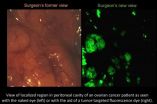(Press-News.org) WEST LAFAYETTE, Ind. - The first fluorescence-guided surgery on an ovarian cancer patient was performed using a cancer cell "homing device" and imaging agent created by a Purdue University researcher.
The surgery was one of 10 performed as part of the first phase of a clinical trial to evaluate a new technology to aid surgeons in the removal of malignant tissue from ovarian cancer patients. The method illuminates cancer cells to help surgeons identify and remove smaller tumors that could otherwise be missed.
Philip Low, the Ralph C. Corely Distinguished Professor of Chemistry who invented the technology, said surgeons were able to see clusters of cancer cells as small as one-tenth of a millimeter, as opposed to the earlier average minimal cluster size of 3 millimeters in diameter based on current methods of visual and tactile detection.
"Ovarian cancer is notoriously difficult to see, and this technique allowed surgeons to spot a tumor 30 times smaller than the smallest they could detect using standard techniques," Low said. "By dramatically improving the detection of the cancer - by literally lighting it up - cancer removal is dramatically improved."
The technique attaches a fluorescent imaging agent to a modified form of the vitamin folic acid, which acts as a "homing device" to seek out and attach to ovarian cancer cells. Patients are injected with the combination two hours prior to surgery and a special camera system, called a multispectral fluorescence camera, then illuminates the cancer cells and displays their location on a flat-screen monitor next to the patient during surgery.
The surgeons involved in this study reported finding an average of 34 tumor deposits using this technique, compared with an average of seven tumor deposits using visual and tactile observations alone. A paper detailing the study was published online Sunday (Sept. 18) in Nature Medicine.
Gooitzen van Dam, a professor and surgeon at the University of Groningen in The Netherlands where the surgeries took place, said the imaging system fits in well with current surgical practice.
"This system is very easy to use and fits seamlessly in the way surgeons do open and laparoscopic surgery, which is the direction most surgeries are headed in the future," said van Dam, who is a surgeon in the division of surgical oncology and Bio-Optical Imaging Center at the University of Groningen. "I think this technology will revolutionize surgical vision. I foresee it becoming a new standard in cancer surgery in a very short time."
Research has shown that the less cancerous tissue that remains, the easier it is for chemotherapy or immunotherapy to work, Low said.
"With ovarian cancer it is clear that the more cancer you can remove, the better the prognosis for the patient," he said. "This is why we chose to begin with ovarian cancer. It seemed like the best place to start to make a difference in people's lives."
By focusing on removal of malignant tissue as opposed to evaluating patient outcome, Low dramatically reduced the amount of time the clinical trial would take to complete.
"What we are really after is a better outcome for patients, but if we had instead designed the clinical trial to evaluate the impact of fluorescence-guided surgery on life expectancy, we would have had to follow patients for years and years," he said. "By instead evaluating if we can identify and remove more malignant tissue with the aid of fluorescence imaging, we are able to quantify the impact of this novel approach within two hours after surgery. We hope this will allow the technology to be approved for general use in a much shorter time."
Low and his team are now making arrangements to work with the Mayo Clinic for the next phase of clinical trials.
The technology is based on Low's discovery that folic acid, or folate, can be used like a Trojan horse to sneak an imaging agent or drug into a cancer cell. Most ovarian cancer cells require large amounts of the vitamin to grow and divide, and special receptors on the cell's surface grab the vitamin - and whatever is linked to it - and pull it inside. Not all cancer cells express the folate receptor, and a simple test is necessary to determine if a specific patient's cancer expresses the receptor in large enough quantities for the technique to work, he said.
Ovarian cancer has one of the highest rates of folate receptor expression at about 85 percent. Approximately 80 percent of endometrial, lung and kidney cancers, and 50 percent of breast and colon cancers also express the receptor, he said.
Low also is investigating targeting molecules that could be used to carry attached imaging agents or drugs to forms of cancer that do not have folate receptors.
He next plans to develop a red fluorescent imaging agent that can be seen through the skin and deep into the body. The current agent uses a green dye that had already been through the approval process to be used in patients, but cannot easily be seen when present deep in tissue. Green light uses a relatively short wavelength that limits its ability to pass through the body, whereas the longer wavelengths of a red fluorescent dye can easily be seen through tissue.
"We want to be able to see deeper into the tissue, beyond the surface," Low said. "Different cancers have tumors with different characteristics, and some branch and wind their way deeper into tissue. We will continue to evolve this technology and make improvements that help cancer patients."
In addition to Low and van Dam, the paper's authors include George Themelis, Athanasios Sarantopoulos and Vasilis Ntziachristos of the Institute for Biological and Medical Imaging at the Technical University of Munich in Germany; Lucia Crane, Niels Harlaar, Rick Pleijhuis, Wendy Kelder and Johannes de Jong of the division of surgical oncology of the BioOptical Imaging Center at the University of Groningen; Henriette Arts and Ate van der Zee of the division of gynaecological oncology at the University of Groningen; and Joost Bart of the Department of Pathology and Molecular Biology of the University Medical Center of Groningen.
Low is the chief science officer for Endocyte Inc., a Purdue Research Park-based company that develops receptor-targeted therapeutics for the treatment of cancer and autoimmune diseases. Endocyte holds the license to the folate receptor-targeting technology and is spinning this technology off into a new company called OnTarget.
Ntziachristos led the team at the Technical University of Munich that developed the camera system. A startup company named SurgOptix BV is working to commercialize the camera system.
INFORMATION:
The clinical trial was funded by Endocyte Inc. and the University Medical Center of Groningen.
Writer: Elizabeth K. Gardner, 765-494-2081, ekgardner@purdue.edu
Sources: Philip Low, 765-494-5273, plow@purdue.edu
Gooitzen van Dam, 31-50-3612283, g.m.van.dam@chir.umcg.nl
Related website:
Philip Low research page: http://www.chem.purdue.edu/low/
VIDEO CAPTION:
Fluorescence-guided surgery on an ovarian cancer patient is shown.
Video is available at http://www.youtube.com/watch?v=CcUFTLVonqs
IMAGE CAPTION:
A surgeon's view of ovarian cancer cells with and without the tumor-targeted fluorescent imaging agent. (Image courtesy of Philip Low)
A publication-quality image is available at http://news.uns.purdue.edu/images/2011/low-fluorescent.jpg
PHOTO:
Philip Low - http://news.uns.purdue.edu/images/2011/low-labshot.jpg
Abstract on the research in this release is available at: http://www.purdue.edu/newsroom/research/2011/110918LowSurgery.html
Purdue technology used in first fluorescence-guided ovarian cancer surgery
2011-09-19
ELSE PRESS RELEASES FROM THIS DATE:
Nanoparticles cause brain injury in fish
2011-09-19
Scientists at the University of Plymouth have shown, for the first time in an animal, that nanoparticles have a detrimental effect on the brain and other parts of the central nervous system.
They subjected rainbow trout to titanium oxide nanoparticles which are widely used as a whitening agent in many products including paints, some personal care products, and with applications being considered for the food industry. They found that the particles caused vacuoles (holes) to form in parts of the brain and for nerve cells in the brain to die. Although some effects of nanoparticles ...
Milking the pigeon: extracting the mechanisms involved
2011-09-19
Production of crop milk, a secretion from the crops of parent birds, is rare among birds and, apart from pigeons, is only found in flamingos and male emperor penguins. Essential for the growth and development of the young pigeon squab, pigeon 'milk' is produced by both parents from fluid-filled cells lining the crop that are rich in fat and protein. Research published in BioMed Central's open access journal BMC Genomics uses new technology to study the genes and proteins involved in pigeon 'milk' production and shows that pigeon 'milk' contains antioxidants and immune-enhancing ...
Reassurance for dementia sufferers on impact of common drugs
2011-09-19
Researchers whose findings on the detrimental impact of some common medicines on elderly people were widely reported earlier in the summer have found that taking a few of these medicines does not appear to cause further cognitive impairment in those already suffering from dementia.
In a paper published today by the journal Age and Ageing, Dr Chris Fox of the University of East Anglia (UEA) and colleagues from a number of other universities and the NHS describe how they studied a clinically representative sample of 224 people with established Alzheimer's dementia who ...
For unzipping DNA mysteries -- literally -- Cornell physicists discover how a vital enzyme works
2011-09-19
ITHACA, N.Y. – With an eye toward understanding DNA replication, Cornell researchers have learned how a helicase enzyme works to actually unzip the two strands of DNA. (Nature, online Sept. 18, 2011.)
At the heart of many metabolic processes, including DNA replication, are enzymes called helicases. Acting like motors, these proteins travel along one side of double-stranded DNA, prompting the strands to "zip" apart.
What had been a mystery was the exact mechanics of this vital biological process – how individual helicase subunits coordinate and physically cause the unzipping ...
Gamers succeed where scientists fail
2011-09-19
Gamers have solved the structure of a retrovirus enzyme whose configuration had stumped scientists for more than a decade. The gamers achieved their discovery by playing Foldit, an online game that allows players to collaborate and compete in predicting the structure of protein molecules.
After scientists repeatedly failed to piece together the structure of a protein-cutting enzyme from an AIDS-like virus, they called in the Foldit players. The scientists challenged the gamers to produce an accurate model of the enzyme. They did it in only three weeks.
This class ...
U of T-led research improves performance of next-generation solar cell technology
2011-09-19
TORONTO, ON – Researchers from the University of Toronto (U of T), the King Abdullah University of Science & Technology (KAUST) and Pennsylvania State University (Penn State) have created the most efficient solar cell ever made based on collodial-quatum-dots (CQD).
The discovery is reported in the latest issue of Nature Materials.
Quantum dots are nanoscale semiconductors that capture light and convert it into an energy source. Because of their small scale, the dots can be sprayed on to flexible surfaces, including plastics. This enables the production of solar cells ...
Catching a breath -- wirelessly
2011-09-19
SALT LAKE CITY, Sept. 19, 2011 – University of Utah engineers who built wireless networks that see through walls now are aiming the technology at a new goal: noninvasively measuring the breathing of surgery patients, adults with sleep apnea and babies at risk of sudden infant death syndrome (SIDS).
Because the technique uses off-the-shelf wireless transceivers similar to those used in home computer networks, "the cost of this system will be cheaper than existing methods of monitoring breathing," says Neal Patwari, senior author of a study of the new method and an assistant ...
ADHD symptoms worsen quality of life for individuals with autism
2011-09-19
NEW YORK, N.Y. (September 18, 2011) – Research supported by the Autism Speaks Autism Treatment Network (ATN), demonstrating that symptoms of attention deficit and hyperactivity worsen quality of life for individuals with autism spectrum disorders (ASD), was presented today at the Society for Developmental & Behavioral Pediatrics Annual Meeting in San Antonio, Texas. Researchers Parul Vora, M.D., developmental-behavioral pediatric fellow at Nationwide Children's and Darryn Sikora, Ph.D., Director of the Autism Program at Oregon Health Sciences University, used data exclusively ...
Minimizing extinctions in a changing climate: New study
2011-09-19
More species could be saved from extinction under climate change thanks to a new model scientists have developed to guide allocation of conservation funding.
The international team, led by Dr Brendan Wintle of the University of Melbourne and the ARC Centre of Excellence for Environmental Decisions, is the first to develop a pioneering decision-support model that incorporates both ecological and economic information to guide conservation investment in the face of climate change. The work is published today [Monday 19 September] in the journal Nature Climate Change.
"The ...
We are not only eating 'materials', we are also eating 'information'
2011-09-19
In a new study, Chen-Yu Zhang's group at Nanjing university present a rather striking finding that plant miRNAs could make into the host blood and tissues via the route of food-intake. Moreover, once inside the host, they can elicit functions by regulating host "target" genes and thus regulate host physiology.
MicroRNAs are a class of 19-24 nucleotide non-coding RNAs that do not code for proteins. MicroRNAs bind to target messenger RNAs to inhibit protein translation. In previous studies, the same group has demonstrated that stable microRNAs (miRNAs) in mammalian serum ...



